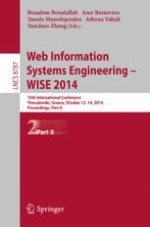2014 | Buch
Web Information Systems Engineering – WISE 2014
15th International Conference, Thessaloniki, Greece, October 12-14, 2014, Proceedings, Part II
herausgegeben von: Boualem Benatallah, Azer Bestavros, Yannis Manolopoulos, Athena Vakali, Yanchun Zhang
Verlag: Springer International Publishing
Buchreihe : Lecture Notes in Computer Science
